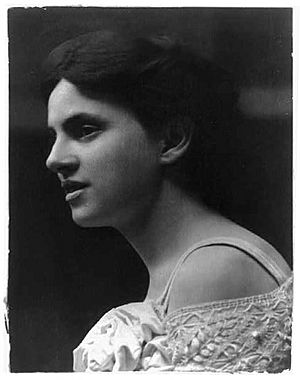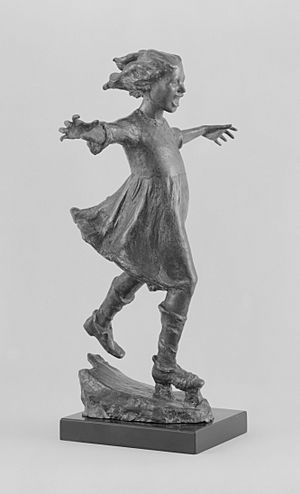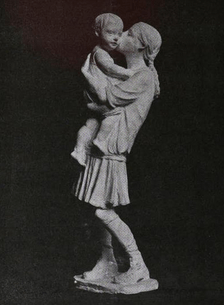Abastenia St. Leger Eberle facts for kids
Quick facts for kids
Abastenia St. Leger Eberle
|
|
|---|---|
 |
|
| Born | April 6, 1878 Webster City, Iowa, United States
|
| Died | February 26, 1942 (aged 63) |
| Nationality | American |
| Known for | Sculpture |
|
Notable work
|
Girl Skating (1907) White Slave (1913) |
| Movement | Ashcan School New Sculpture Realism |
Abastenia St. Leger Eberle (born April 6, 1878 – died February 26, 1942) was an American sculptor. She was famous for her lively, small bronze sculptures. These artworks often showed poor immigrants living in New York City's Lower East Side.
Eberle believed that artists should create art that showed important social issues. She spent much of her life working for equal rights for women in America. She also pushed for equality for everyone.
Contents
Early Life and Discovering Art
Abastenia St. Leger Eberle was born on April 6, 1878, in Webster City, Iowa. Her mother was a musician, and her father was a doctor in the US Army. Her family moved several times before settling in Canton, Ohio.
Eberle first planned to become a professional musician. She was very good at playing the cello. But one day, her father saw a clay mask she had made. He was so impressed that he got her some special modeling wax. This wax came from a patient who made sculptures.
Eberle quickly realized that sculpture was her true calling. She said, "I knew it [sculpture] was my work." She took lessons from her father's patient. Later, she enrolled at the Art Students League in New York City.
Starting Her Career
After getting the modeling wax, Eberle started copying tombstones and memorials. These were the only sculptures she could study in Canton. She really wanted more art training. So, she helped organize a class with sculptor Frank Vogan in Canton. Eberle studied with Vogan for two years. She said his lessons were very helpful for her art.
In 1899, when she was 21, Eberle began training with George Grey Barnard in New York. Barnard was a well-known sculptor. Eberle made such a good impression that he sometimes left her in charge of the class.
Eberle visited her family in Puerto Rico, where her father was working. There, she made quick clay sketches of everyday street scenes. Her sculpture Puerto Rican Mother and Child (1901) was one of her first works showing the lives of ordinary people. She quickly gained recognition for her talent.
Eberle also worked with another artist, Anna Hyatt Huntington. They created a sculpture called Men and Bull. It was shown at an important art exhibition in 1904. In 1906, Huntington and Eberle decided to work separately. Huntington focused on animal sculptures. Eberle, however, chose to create small bronzes about social issues. She wanted to show the lives of lower-class immigrants.
In 1907, Eberle finished Girl Skating. This sculpture showed a young girl roller skating down the street. It was her first artwork about street life in New York. In 1906, she became a member of the National Sculpture Society. Later, in 1920, she joined the National Academy of Design. Eberle's style was similar to Art Nouveau and the New Sculpture movement.
Later Career and Social Art
In 1907, Eberle traveled to Naples, Italy. She went there to watch her bronze sculptures being made. The workers at the foundry were surprised to see a woman doing this kind of work. But they soon respected her attention to detail. Eberle cared about the workers and their families. She even made sure they had a good breakfast each day.
When Eberle returned to New York, she felt inspired by the city's energy. She wanted to show the "modern spirit" of everyday life. That summer, she worked as a settlement worker on the Lower East Side. This helped her "study the people there and the conditions under which they live." She often used children playing as subjects for her art, like in Bubbles (1908).
Eberle moved her studio to Greenwich Village. This area was known for its many immigrants and its free lifestyle. Here, she created some of her most powerful works. She made sculptures of working-class children playing and working. These pieces showed the "vitality of the city's immigrant population."
Some of her works called for social change. For example, Ragpicker (1911) showed someone collecting rags. Old Woman Picking Up Coal (1906) showed a poor Italian woman searching for coal to heat her home.
Later, Eberle moved her studio right into New York's Lower East Side. She wanted to be closer to the people she sculpted. She set up her studio with a playroom. She used stories and toys to bring children to her studio. This way, she could sculpt them directly.
Eberle was also very involved in the women's suffrage movement. This movement fought for women's right to vote. She took part in a suffrage parade for women sculptors in 1911. She was also deeply committed to the feminist movement.
From 1907 to 1913, Eberle showed her work at the Macbeth Gallery in Manhattan. Her sculptures did not always sell for much money. So, she made and sold bronze tobacco jars and bookends to earn a living.
In 1913, Eberle was invited to show her art at the famous Armory Show. She submitted Girls Wading (1913), which showed three girls at Coney Island Beach. She also submitted another sculpture called White Slave (1913).
By 1930, Eberle had to leave New York due to money and health problems. She moved to Westport, Connecticut. She also entered her sculptures in the 1928 and 1932 Summer Olympics, but she did not win a medal.
Eberle believed that art should have a social purpose. She wrote that artists "had no right to work as an individualist with no responsibility to others. [Artists] must see for people—reveal them to themselves and each other." Some of her sculptures are in the Metropolitan Museum of Art. You can also see several of her works at the Kendall Young Library in Webster City, Iowa, where she was born.
Exhibitions
"Girl Skating"
- Smithsonian American Art Museum, 2011–Present.
"White Slave"
- Armory Show, A Turning Point, 1913, NYC
- Knoxville Museum of Art, American Women Artists: The 20th Century, Oct. 26, 1989–Feb. 4, 1990
- Queensboro Community College Art Gallery. March 11, 1990–Apr.5, 1990
- The Discovery Museum, Bridgeport, CT, They Earned Their Keep/ The Struggles and Successes of American Women Artists, Apr. 10, 1993 – May 30, 1993
- Parrish Art Museum, Southampton, NY Feb. 20, 1994–Apr. 10, 1994
- Los Angeles County Museum of Art, Figure in American Sculpture, Feb. 23, 1995 – May 14, 1995
- Montgomery Museum of Fine Arts, June 22, 1995–Sept. 10, 1995
- Wichita Art Museum, Oct. 19, 1995–Jan. 7, 1996
- National Academy of Design, Feb. 15, 1996 – May 5, 1996
- Whitney Museum of American Art, NYC: Part 1: The American Century Art and Culture, 1900–2000, Apr. 23, 1999–Aug. 22, 1999



